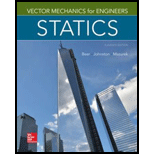Given information:
The thickness (t) of the anchor is 0.05 in.
The specific weight (γ) of the galvanized steel is 470 lb/ft3.
Assume the acceleration due to gravity (g) as 32.2 ft/s2
Calculation:
Show the section 1, section 2 and section 3 of the framing anchor as in Figure 1.

Calculate the density (ρ) of the galvanized steel using the relation:
ρ=γg
Substitute 470 lb/ft3 for γ and 32.2 ft/s2 for g.
ρ=47032.2=14.596 lb⋅s2/ft4
Calculate the volume of the section 1 (V1) using the relation:
V1=A1t=3.5×2.25×t
Substitute 0.05 in. for t.
V1=3.5×2.25×0.05=0.39375 in.3×(1 ft12 in.)3=2.2786×10−4ft3
Calculate the volume of the section 2 (V2) as below:
V2=A2t=1×2.25×t
Substitute 0.05 in. for t.
V2=1×2.25×0.05=0.1125 in.3×(1 ft12 in.)3=6.5104×10−5ft3
Calculate the volume (V3) of the section 3 as below:
V3=A3t=12(3.5+1.25)×2×t
Substitute 0.05 in. for t.
V3=12×(3.5+1.25)×2×0.05=0.2375 in.3×(1 ft12 in.)3=1.3744×10−4ft3
Calculate the mass of section 1 (m1) using the relation:
m1=ρV1
Substitute 2.2786×10−4ft3 for V1 and 14.596 lb⋅s2/ft4 for ρ.
m1=14.596 ×2.2786×10−4=3325.845×10−6 lb⋅s2/ft
Calculate the mass of section 2 (m2) using the relation:
m2=ρV2
Substitute 6.5104×10−5ft3 for V2 and 14.596 lb⋅s2/ft4 for ρ.
m2=14.596 ×6.5104×10−5=950.26×10−6 lb⋅s2/ft
Calculate the mass of section 3 (m3) using the relation:
m3=ρV3
Substitute 1.3744×10−4ft3 for V3 and 14.596 lb⋅s2/ft4 for ρ.
m3=14.596 ×1.3744×10−4=2006.14×10−6 lb⋅s2/ft
Calculate the mass moment of inertia with respect to x axis for section 1 (Ix)1 as below:
(Ix)1=112(m1)(3.5)2+(m1×(3.52)2)
Substitute 3325.845×10−6 lb⋅s2/ft for m1.
(Ix)1=112(3325.845×10−6 lb⋅s2/ft)(3.5 in.×1 ft12 in.)2+(3325.845×10−6 lb⋅s2/ft×((3.5 in.)×1 ft12 in.2)2)=2.3577×10−5+7.073×10−5=9.4307 ×10−5 lb⋅ft⋅s2
Calculate the mass moment of inertia with respect to x axis for section 2 (Ix)2 as below:
(Ix)2=112(m2)(1)2+(m2×(3.52+(12)2))
Substitute 950.26×10−6 lb⋅s2/ft for m2.
(Ix)2=112(950.26×10−6 lb⋅s2/ft)(1in.×1 ft12 in.)2+(950.26×10−6 lb⋅s2/ft× ((3.5 in.×1 ft12 in.)2+((1in.×1 ft12 in.)2)2))=5.4992×10−7+8.2488×10−5=83.037×10−6 lb⋅ft⋅s2
Calculate the mass moment of inertia with respect to x axis for section 3 (Ix)3 as below:
(Ix)3=118(m3)((3.5+1.25)2+22)+(m3×((23(3.5+1.25))2+(13×2)2))
Substitute 2006.14×10−6 lb⋅s2/ft for m3.
(Ix)3=118(2006.14×10−6 lb⋅s2/ft)(((3.5+1.25)in.×1 ft12 in.)2+(2in.×1 ft12 in.)2)+ +(2006.14×10−6 lb⋅s2/ft×((23((3.5+1.25)in.×1 ft12 in.))2+(13×2in.×1 ft12 in.)2))=2.0558×10−5+1.4589×10−4=166.452×10−6 lb⋅ft⋅s2
Calculate the mass moment of inertia with respect to x axis for anchor (Ix) using the parallel axis theorem as below:
Ix=(Ix)1+(Ix)2+(Ix)3
Substitute 9.4307 ×10−5 lb⋅ft⋅s2 for (Ix)1, 83.037×10−6 lb⋅ft⋅s2 for (Ix)2 and 166.452×10−6 lb⋅ft⋅s2 for (Ix)3.
Ix=9.4307 ×10−5 +83.037×10−6 +166.452×10−6=3.437×10−4 lb⋅ft⋅s2≈344×10−6 lb⋅ft⋅s2
Calculate the mass moment of inertia with respect to y axis for section 1 (Iy)1 as below:
(Iy)1=112m1(2.25)2+m1(2.252)2
Substitute 3325.845×10−6 lb⋅s2/ft for m1.
(Iy)1={112×3325.845×10−6 lb⋅s2/ft×(2.25 in.×1 ft12 in.)2 +3325.845×10−6 lb⋅s2/ft×((2.25in.×1 ft12 in.)2)2}=9.7436×10−6+2.923×10−5=38.975×10−6 lb⋅ft⋅s2
Calculate the mass moment of inertia with respect to y axis for section 2 (Iy)2 as below:
(Iy)2=112m2((2.25)2+(1)2)+m2[(2.252)2+(12)2]
Substitute 950.26×10−6 lb⋅s2/ft for m2.
(Iy)2={112(950.26×10−6 lb⋅s2/ft)((2.25in.×1 ft12 in.)2+(1in.×1 ft12 in.)2) +950.26×10−6 lb⋅s2/ft[((2.25in.×1 ft12 in.)2)2+(1in.×1 ft12 in.2)2]}=3.334×10−6+1.00017×10−5=13.336×10−6 lb⋅ft⋅s2
Calculate the mass moment of inertia with respect to y axis for section 3 (Iy)3 as below:
(Iy)3=118m3(2)2+m3[2.252+(132)2]
Substitute 2006.14×10−6 lb⋅s2/ft for m3.
(Iy)3={118×2006.14×10−6 lb⋅s2/ft(2in.×1 ft12 in.)2 +2006.14×10−6 lb⋅s2/ft[(2.25in.×1 ft12 in.)2+(13×(2in.×1 ft12 in.))2]}=3.096×10−6+7.672×10−5=79.816×10−6 lb⋅ft⋅s2
Calculate the mass moment of inertia with respect to y axis for anchor (Iy) using the parallel axis theorem as below:
Iy=(Iy)1+(Iy)2+(Iy)3
Substitute 38.975×10−6lb⋅ft⋅s2 for (Iy)1 13.336×10−6 lb⋅ft⋅s2 for (Iy)2 and 79.816×10−6lb⋅ft⋅s2 for (Iy)3.
Iy=38.975×10−6 +13.336×10−6+79.816×10−6=132.127×10−6 lb⋅ft⋅s2≈132.1×10−6 lb⋅ft⋅s2
Calculate the mass moment of inertia with respect to z axis for section 1 (Iz)1 as below:
(Iz)1=112m1[(2.25)2+(3.5)2]+m1[(2.252)2+(3.52)2]
Substitute 3325.845×10−6 lb⋅s2/ft for m1.
(Iz)1={1123325.845×10−6 lb⋅s2/ft[(2.25in.×1 ft12 in.)2+(3.5in.×1 ft12 in.)2] +3325.845×10−6 lb⋅s2/ft[(2.25in.×1 ft12 in.2)2+(3.5in.×1 ft12 in.2)2]}=3.332×10−5+9.996×10−5=133.283×10−6lb⋅ft⋅s2
Calculate the mass moment of inertia with respect to z axis for section 2 (Ix)2 as below:
(Iz)2=112m2(2.25)2+m2[(2.252)2+(3.5)2]
Substitute 950.26×10−6 lb⋅s2/ft for m2.
(Iz)2={112×950.26×10−6 lb⋅s2/ft×(2.25in.×1 ft12 in.)2 +950.26×10−6 lb⋅s2/ft×[(2.25in.×1 ft12 in.2)2+(3.5in.×1 ft12 in.)2]}=2.784×10−6+8.918×10−5=91.974×10−6 lb⋅ft⋅s2
Calculate the mass moment of inertia with respect to z axis for section 3 (Iy)3 as below:
(Iz)3=118m3(3.5+1.25)2+m3[(2.25)2+(23(3.5+1.25))2]
Substitute 2006.14×10−6 lb⋅s2/ft for m3.
(Iz)3={118×2006.14×10−6 lb⋅s2/ft((3.5+1.25)in.×1 ft12 in.)2 +2006.14×10−6 lb⋅s2/ft×[(2.25in.×1 ft12 in.)2+(23((3.5+1.25)in.×1 ft12 in.))2]}=1.746×10−6+2.102×10−4=227.694×10−6 lb⋅ft⋅s2
Calculate the mass moment of inertia with respect to z axis for anchor (Ix) using the parallel axis theorem as below:
Iz=(Iz)1+(Iz)2+(Iz)3
Substitute 133.283×10−6lb⋅ft⋅s2 for (Iz)1 91.974×10−6 lb⋅ft⋅s2 for (Iz)2 and 227.694×10−5 lb⋅ft⋅s2 for (Iz)3.
Iz=133.283×10−6+91.974×10−6 +2.27.694×10−6 =452.951×10−6 lb⋅ft⋅s2≈453×10−6 lb⋅ft⋅s2
Therefore, the mass moment of inertia (Ix) of the anchor with respect to x axis is 344×10−6 lb⋅ft⋅s2_.
Therefore, the mass moment of inertia (Iy) of the anchor with respect to y axis is 132.1×10−6 lb⋅ft⋅s2_.
Therefore, the mass moment of inertia (Iz) of the anchor with respect to z axis is 453×10−6 lb⋅ft⋅s2_.


 Elements Of ElectromagneticsMechanical EngineeringISBN:9780190698614Author:Sadiku, Matthew N. O.Publisher:Oxford University Press
Elements Of ElectromagneticsMechanical EngineeringISBN:9780190698614Author:Sadiku, Matthew N. O.Publisher:Oxford University Press Mechanics of Materials (10th Edition)Mechanical EngineeringISBN:9780134319650Author:Russell C. HibbelerPublisher:PEARSON
Mechanics of Materials (10th Edition)Mechanical EngineeringISBN:9780134319650Author:Russell C. HibbelerPublisher:PEARSON Thermodynamics: An Engineering ApproachMechanical EngineeringISBN:9781259822674Author:Yunus A. Cengel Dr., Michael A. BolesPublisher:McGraw-Hill Education
Thermodynamics: An Engineering ApproachMechanical EngineeringISBN:9781259822674Author:Yunus A. Cengel Dr., Michael A. BolesPublisher:McGraw-Hill Education Control Systems EngineeringMechanical EngineeringISBN:9781118170519Author:Norman S. NisePublisher:WILEY
Control Systems EngineeringMechanical EngineeringISBN:9781118170519Author:Norman S. NisePublisher:WILEY Mechanics of Materials (MindTap Course List)Mechanical EngineeringISBN:9781337093347Author:Barry J. Goodno, James M. GerePublisher:Cengage Learning
Mechanics of Materials (MindTap Course List)Mechanical EngineeringISBN:9781337093347Author:Barry J. Goodno, James M. GerePublisher:Cengage Learning Engineering Mechanics: StaticsMechanical EngineeringISBN:9781118807330Author:James L. Meriam, L. G. Kraige, J. N. BoltonPublisher:WILEY
Engineering Mechanics: StaticsMechanical EngineeringISBN:9781118807330Author:James L. Meriam, L. G. Kraige, J. N. BoltonPublisher:WILEY




